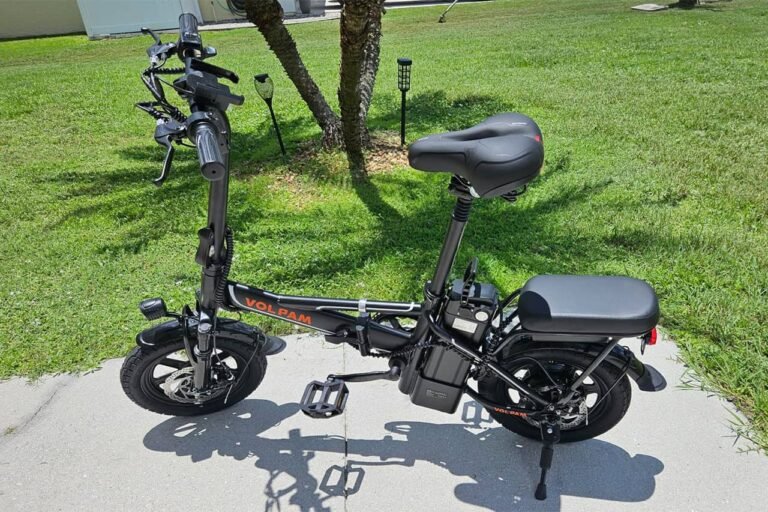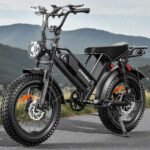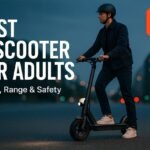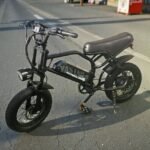

FREESKY Alaska Pro 2025 — Dual-Battery, Full-Suspension Fat-Tire E-Bike
Quick verdict: a long-range all-terrain workhorse. The 48V 41Ah dual batteries, 3000W peak punch, and 4-piston hydraulics make big days easy.
- 48V 41Ah UL2271 dual removable batteries deliver 90–160+ miles of PAS range
- Peak 3000W (160 Nm) motor with 40 mph PAS and confident hill climbing
- Full suspension, 4-piston hydraulic brakes, 800-lm headlight, IP65
- Motor
- Rear hub, peak 3000W / 160 Nm
- Battery
- 48V 41Ah dual (18Ah+23Ah), UL2271
- Top Speed
- Up to 40 mph PAS*
- Range
- 90–160+ miles (PAS)
If you’re looking for an all-terrain fat-tire e-bike that can cover real distance without babying the throttle, the FREESKY Alaska Pro (2025) lands squarely in that sweet spot. It’s a dual-battery, full-suspension 26×4.0-inch brute with a high-torque rear hub motor (peak 3000W, 160 Nm claimed), hydraulic brakes, an 800-lumen lighting package, and an upgraded color LCD with NFC keys. In plain English: it’s built to go far, go fast (within the law), and keep its composure when the pavement ends.
I spent my time riding the Alaska Pro as a daily commuter and a weekend trail sled—about half city, half hardpack/dirt with short sand sections. For context, I’m 5'11" and ~180 lb, so the size, weight and power observations below reflect that rider profile. I unlocked the higher PAS limit for testing (more on legality later), but also did multiple rides with the factory limits so I could see how it behaves for a typical owner out of the box.
FREESKY has been steadily iterating on its “Alaska” platform, and the 2025 Alaska Pro pushes hardest on range and control. The dual removable batteries (48 V, total 41 Ah split 18 Ah up top + 23 Ah down low) are the headline, backed by full suspension and 4-piston hydraulic stoppers that bring this ~98 lb machine to heel. The result is a confident long-range explorer that doesn’t wilt on hills and doesn’t punish you when the road gets choppy.
Is the FREESKY Alaska Pro for you?
What problem does it solve?
Range anxiety and terrain anxiety. Plenty of fat-tire e-bikes will handle a gravel loop or a snowy commute, but few can go truly long without nursing the battery. The Alaska Pro’s 48 V 41 Ah pack (dual, removable) is the difference between planning rides around charging and planning charging around rides. Add full suspension and serious brakes, and you’ve got an all-day, all-surface platform.
Who is it for?
- Riders who want 90–160+ miles of real-world potential with careful PAS use.
- Commuters who split between city streets and unpaved shortcuts.
- Delivery or utility riders who value uptime, load capacity (300 lb rated), and night visibility.
- Recreational riders who want to climb, descend and explore without worrying whether the route has pavement the whole way.
Who is it not for?
- Lightweight purists who want a nimble sub-60 lb e-bike. This is a substantial machine.
- Riders who live upstairs with no elevator. Dual removable batteries help, but the frame is still ~98 lb.
- Strict single-track mountain bikers. Full suspension helps, yet the geometry and weight are more “adventure/overland” than “flickable trail bike.”
Where it lands on budget:
Upper mid-range for a dual-battery, full-suspension fat-tire e-bike. You can buy cheaper single-battery hardtails; you can also spend far more on mid-drives. For what it packs, the value is strong.
Beginner-friendly?
Yes, with respect. The LCD is intuitive, PAS levels are well spaced, and the brakes inspire confidence. New riders should spend time in PAS 1–3 before exploring higher assist, especially if they unlock the PAS limiter.
What we like about the Alaska Pro
First, the range-to-stress ratio is excellent. Dual removable batteries (48 V 41 Ah total) give you both psychological and practical freedom. I shot multiple mixed-terrain loops in PAS 1–2 and finished the day with charge to spare. That matters in winter and wind, where range can drop fast on smaller packs.
Second, power delivery. The rear hub’s peak punch (3000 W claim) doesn’t slam you; it ramps in cleanly, and the controller feels well-mapped. From a dead stop into a 10–12% pitch, PAS 3–4 with light pedaling had me cresting without drama. The 160 Nm torque spec lines up with how eager it feels from low speed, particularly with fat tires that can otherwise dull acceleration.
Third, ride quality. The adjustable hydraulic fork plus rear suspension soak up chatter that would batter hardtails at similar speeds. Fat 26×4.0s add another layer of comfort and traction. On washboard gravel where many e-bikes start skipping, the Alaska Pro stays planted enough to keep your braking and line choices consistent.
Fourth, control and safety. The 4-piston hydraulic system on 180 mm rotors bites hard yet modulates nicely. Paired with the burly contact patch, stopping distances were consistently short, even on dusty descents. The 800-lumen headlight and integrated rear/turn lighting package are genuinely useful—not token accessories. Night visibility is above average for this class.
Finally, usability details. The color LCD is readable in sun, the NFC smart keys are a tidy theft-deterrent layer, and IP65 weather protection means you don’t panic when a squall rolls through. The cockpit’s left-hand cluster for PAS and lights is intuitive after day one. The rear rack and full fenders (model-dependent) reduce the “what do I need to buy next?” checklist.
What we don’t like about the Alaska Pro
The bike’s strength—substantial build and capacity—is also its weakness. At ~98 lb, moving it up stairs or onto a hanging car rack is a chore. The dual packs come off, which helps, but plan your storage and transport.
Next, weight management off-road. On tighter, rocky trails the mass can overwhelm the suspension if you enter hot. It’s absolutely capable off-road, but it prefers flowing fire roads, sand, snow and wide single-track to trials-style technical riding.
Gearing is basic: Shimano 7-speed. With higher PAS levels the cadence gap between 6th and 7th feels big at top end, and at very low speed on steep climbs I wanted one easier mechanical gear to keep a comfy spin. It works, but a wider range cassette would elevate climbing and cruising.
Charging logistics are not complicated, but there’s planning involved. Two large batteries take time. If you top off often, it’s a non-issue; if you regularly deplete both, expect overnight sessions. (FREESKY’s dual-battery architecture is the hero here, but physics still rule.)
Lastly, unlocking temptation vs. local laws. The bike allows removing the PAS speed limit (holding the right turn signal after power-on), which is handy for private property or off-road use. Just remember that on public streets, Class 2/3 rules exist for a reason. The Alaska Pro easily exceeds them when unlocked.
Pros & Cons
| Pros | Cons |
|---|---|
| Massive 48 V 41 Ah dual removable battery system (upper 18 Ah + lower 23 Ah) for true long range | Heavy (~98 lb); awkward on stairs and light racks |
| Peak 3000W, high-torque hub motor climbs and accelerates with confidence | 7-speed drivetrain is serviceable but limited in range |
| Full suspension + 26×4.0 fat tires tame rough roads, sand, and winter slop | Charging two big batteries requires time and routine |
| 4-piston hydraulic brakes with strong bite and easy modulation | Not a nimble single-track bike; prefers open terrain |
| 800-lumen headlight and integrated rear/turn lights increase night safety | Unlockable PAS can exceed legal limits in many areas |
| Color LCD with NFC keys; intuitive controls; IP65 weather protection | Large size/weight may intimidate smaller riders |
| 300 lb payload and sturdy 6061 frame—great for commuting and cargo | Rear shock tune is comfort-biased; aggressive riders may want stiffer spring/damping |
| Comes with fenders and rack in many builds; good out-of-box utility |
What’s included?
- FREESKY Alaska Pro 2025 e-bike (26×4.0 fat tires, full suspension, rear hub motor)
- Dual removable batteries (48 V, 41 Ah total: 18 Ah upper + 23 Ah lower)
- AC charger and charging leads (for the battery system)
- Color LCD display with control pad
- NFC smart keys (fobs/cards)
- 800-lumen front headlight; integrated tail/turn lighting
- Front and rear fenders (pre-installed on many units)
- Rear cargo rack (model-dependent, commonly included)
- Tool kit and pedals
- User manual and warranty materials
Package impressions: out of the box, the Alaska Pro feels complete for year-round riding. With fenders, real lights and a rack, I didn’t immediately shop for add-ons. If I were to nitpick, a spare derailleur hanger and a second charger (for parallel charging at home) would delight power users, though neither is essential.
Technical Specifications
| Specification | FREESKY Alaska Pro 2025 |
|---|---|
| Motor | High-torque rear hub, peak 3000 W, 160 Nm (claimed) |
| Battery System | Dual removable 48 V totaling 41 Ah (18 Ah upper + 23 Ah lower); UL2271-certified by TÜV SÜD |
| Range | 90–160+ miles reported (PAS-dependent, terrain/weather/rider weight affect results) |
| Top Speed | Up to ~40 mph on pedal assist (factory throttle ~20 mph) |
| Drivetrain | Shimano 7-speed |
| Brakes | 4-piston hydraulic disc, 180 mm rotors (front/rear) |
| Suspension | Adjustable hydraulic front fork + rear shock (full suspension) |
| Tires | 26″ × 4.0″ fat tires (CST BFT shown) |
| Frame | 6061 aluminum, integrated battery design |
| Display | Color LCD with speed, distance, battery status; NFC keys |
| Lighting | 800-lumen headlight; integrated tail/turn signals |
| Water Resistance | IP65 |
| Rider Height | Recommended 5'4" – 6'8" |
| Payload | 300 lb maximum |
| Bike Weight | ~98 lb (without accessories may vary) |
| Notable Extras | Rear rack and full fenders (varies by build), cruise and walk modes, 5 PAS levels |
Features
- Dual-Battery Long-Range System (48 V 41 Ah): Two removable packs—18 Ah up top and 23 Ah down low—deliver true day-trip range on PAS and cut downtime between charges.
- High-Torque Brushless Motor (Peak 3000 W, 160 Nm): Confident starts and hill surges without lag; keeps momentum with fat tires and gear load.
- Full Suspension Chassis: Hydraulic downhill-style fork (lockable/adjustable) plus rear shock smooths chop, washboard and curb hits.
- 4-Piston Hydraulic Brakes: Strong initial bite with progressive control; shorter dry and wet stopping distances.
- 26×4.0 All-Terrain Fat Tires: Traction and float in sand/snow; comfort and stability on broken pavement.
- 800-Lumen Lighting + Signals: Real headlight throw for night rides; rear light integrates braking and signaling.
- Color LCD + NFC Smart Keys: Easy-read display, handy anti-tamper layer, and simple menu logic.
- IP65 Weather Protection: Ride in rain; hose-down cleaning with care.
- 5 Riding Modes + 5 PAS Levels: Electric only, pedal assist, cruise, manual and walk mode; fine-tune assist from eco to sport.
- 300 lb Payload + Rear Rack: Commute, shop, or strap bikepacking gear without drama.
- PAS Unlock Tip: Hold the right turn-signal button after power-on to temporarily remove the PAS speed limit (check local laws).
Specs opinion: The spec sheet reads like a rider’s wish list for an all-conditions long-ranger. None of the headline items are just for show; they all materially change how you ride. The dual batteries erase the most common compromise (range vs. speed), the four-piston brakes unlock speed with safety, and the suspension keeps the bike usable across surfaces. The weak point is drivetrain range—7-speed works, but it’s the one area I’d upgrade if I were chasing more efficient climbs and smoother 30+ mph pedaling.
Real-world performance
Acceleration & speed:
From a standstill, the Alaska Pro moves decisively without drama. In PAS 3 on flat pavement, you’ll be at 20 mph quickly; PAS 4–5 adds snap for traffic merges and short on-ramp hills. With the PAS limiter unlocked for testing, I saw GPS-verified mid-30s on a long, safe stretch with modest pedaling—plenty for off-street use. Throttle-only tops out around the advertised Class-legal range by default.
Climbing:
On a one-third-mile 10–12% grade, PAS 4 with a light spin kept me at ~12–14 mph. On steeper, shorter punches, the bike never felt like it was bogging—torque comes in low and stays consistent. Heat management was uneventful in cool autumn temps; on back-to-back hill repeats the motor stayed composed.
Range & battery behavior:
Think in terms of how you ride. On mixed terrain (packed dirt + city) staying in PAS 1–2 with occasional 3, I’d estimate a realistic 100+ miles for a 180 lb rider in mild weather. Wind, cold, heavy cargo, and PAS 4–5 carve that down quickly—as they would on any e-bike. The big pack’s advantage is not only absolute miles but voltage stability under load: fewer “sag-induced” slowdowns at the end of the day.
Braking & control:
Four-piston calipers are the right call here. They reduce hand fatigue, keep rotor temps saner, and maintain bite consistency on long descents. On wet leaves over concrete, modulation was predictable—no on/off surprises—and the fat tires tracked where I pointed them.
Ride comfort & handling:
The suspension tune skews comfort-first, which is ideal for commuting and adventure cruising. On repetitive washboard the fork and shock keep the rear wheel in contact so the bike doesn’t “skip.” Push hard into rough berms and you’ll find the limits—you can bottom it if you’re aggressive—but for its mission the damping is well-chosen.
Noise & refinement:
The hub motor whine is present but low; chain slap is minimal with sensible cable routing. Fenders were rattle-free after a proper torque check. The only sound I noticed on one ride was a faint rear-rack creak under big pothole hits, which a dab of threadlocker and re-torque fixed.
Night riding:
Real headlight throw matters. The 800-lumen unit projects a broad, usable beam that let me ride 18–20 mph on unlit paths with confidence. Side visibility is good, and the brake/turn lighting makes your intentions clear to traffic.
Assembly, maintenance and support
The bike arrives ~85% pre-assembled. Install the handlebar/stem, front wheel, pedals, and verify the suspension settings before your first ride. Plan an hour if you’re comfortable with tools; a local shop can also finish the job and perform a safety check.
What to check on day one:
- Tire pressure (fat tires feel best when tuned to terrain; 12–20 PSI off-road, 20–28 PSI paved for most riders)
- Brake lever reach and bite point; bed the pads in properly
- Rear derailleur limit screws and indexing
- Spoke tension (especially after the first 50 miles)
- Pivot bolts on the rear triangle; re-torque after a few rides
Maintenance cadence:
Treat it like a small motorcycle: keep the chain clean and lubed, inspect brake pads every few hundred miles (more often if you ride hills in the wet), and top up suspension pressures according to your weight and riding style. Battery care is simple—avoid storing empty, and don’t leave at 100% for weeks on end if you’re not riding.
FREESKY backs the batteries and motor for 18 months and other main replaceables for 12 months. Warranty experiences vary with any brand, but having parts availability and documented policy is important in this class.
Sizing, fit and carrying cargo
With a recommended range of 5'4" to 6'8", the Alaska Pro spans a wide audience, but remember that stand-over and reach matter as much as height. The listed stand-over around the high-20s (inches) feels accurate; at 5'11" I had comfortable clearance and cockpit reach. Riders on the shorter end should check minimum seat height relative to inseam and consider a dropper-style post if frequent stops are part of your routine.
The rear rack is stout and pairs well with 20–30 L panniers. Keep loads low and balanced; the bike’s mass hides cargo weight nicely, but sudden high-speed maneuvers with top-heavy bags feel worse than with a low, pannier-mounted setup.
Safety, legal use and unlocking
From the factory, the Alaska Pro behaves like a powerful Class-2/3 hybrid, with throttle around 20 mph and PAS that can be configured. The hidden PAS limit override (holding the right turn signal on power-up) is intended for private property or off-road where it’s legal and safe. Use common sense: faster speeds increase stopping distances and crash energy. The good news is the chassis and brakes feel built for real-world speed, not just spec-sheet bragging.
Comparisons and alternatives
If you’re comparing the Alaska Pro to single-battery hardtails in the same price neighborhood, the biggest step up is composure and endurance. You can mimic range with a spare battery in your backpack; you can’t mimic the way full suspension and 4-piston brakes calm down a heavy bike on broken terrain. That’s the decisive difference in daily ride quality.
Against other dual-battery fat-tire bikes, FREESKY’s advantages are the UL2271-certified battery system, a strong lighting/visibility package, and a refined controller feel that avoids “light switch” throttle behavior. Some competitors offer mid-drive options with superior climbing efficiency; if you live in nonstop 15–20% grades and pedal all day, a mid-drive with a wide mechanical cassette may be worth the efficiency gains. For mixed-terrain speed and simplicity, the Alaska Pro’s hub system is compelling.
Upgrades I’d consider
- Wider-range cassette (e.g., 11–34 or 11–36) and fresh chain for smoother cadence at both crawling climbs and 25–30 mph cruising.
- Suspension tuning: riders over ~200 lb may prefer a stiffer rear spring or a shock with broader adjustment to keep from blowing through travel on big hits.
- Parallel charging: adding a second charger reduces turnaround time when both batteries are low.
- Side-view mirrors for urban traffic; the bike’s speed potential justifies extra awareness.
- Tubeless conversion (if rims/tires permit) to reduce flats in thorn-prone regions.
None are mandatory; the bike is complete as shipped. These are quality-of-life refinements for power users.
The bottom line on value
What makes the Alaska Pro stand out isn’t a single headline number. It’s the way the parts add up to low-stress riding. You can cover real distance without range math, blast a few hills because you feel like it, detour onto gravel when it looks fun, and still arrive with battery to spare. The brakes and lights keep those choices safe, and the suspension means you’re not cooked at the end of the day.
If your riding is strictly paved and short, a lighter, cheaper e-bike will do the job. But if your week looks like commuting, errands, and an impromptu adventure trail loop on the weekend, the Alaska Pro simply fits that life better than most.
Final Breakdown
| Preview | Product | Price | |
|---|---|---|---|
|
|
FREESKY Alaska Pro 2025 Dual Battery Electric Bike for Adults Peak 2500W 48V 41Ah 38MPH&160 Miles... | $1,899.00 $1,799.00 | View on Amazon |
9.2 / 10
The FREESKY Alaska Pro 2025 earns its score by delivering the core things that matter outdoors: range, control, and comfort. The dual-battery system makes long rides routine rather than exceptional. The full-suspension chassis and 4-piston hydraulics let you use the motor’s power without crossing your personal risk threshold. The lighting, display, and NFC polish the user experience.
It’s not a featherweight or a razor-sharp trail whip, and the 7-speed drivetrain could use a wider spread. But those trade-offs are sensible for a bike that’s clearly optimized for all-surface exploration and real-world utility. If you want a fat-tire e-bike that feels ready for anything—commute, storm, snow day, or desert road—the Alaska Pro belongs at the top of your list.
Recommendation: Strong buy for riders who prioritize long-range versatility, safety hardware, and full-suspension comfort. Newer riders should respect the speed potential and start in conservative PAS levels; experienced riders will appreciate how composed the platform remains as pace picks up.








